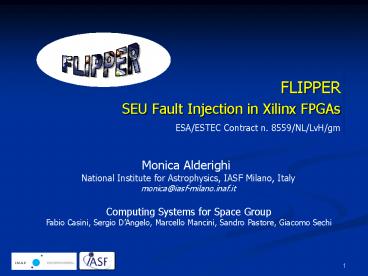FLIPPER - PowerPoint PPT Presentation
Title:
FLIPPER
Description:
Fabio Casini, Sergio D'Angelo, Marcello Mancini, Sandro Pastore, Giacomo Sechi. ESA/ESTEC Contract n. ... SEU emulator comprising hardware, firmware & software ... – PowerPoint PPT presentation
Number of Views:203
Avg rating:3.0/5.0
Title: FLIPPER
1
FLIPPER
- FLIPPER
- SEU Fault Injection in Xilinx FPGAs
ESA/ESTEC Contract n. 8559/NL/LvH/gm
Monica Alderighi National Institute for
Astrophysics, IASF Milano, Italy monica_at_iasf-milan
o.inaf.it
Computing Systems for Space Group Fabio Casini,
Sergio DAngelo, Marcello Mancini, Sandro
Pastore, Giacomo Sechi
2
Outline
- Overview
- Basic principle and main features
- Case study
- Preliminary results
- Conclusions
3
FLIPPER what is it?
FLIPPER is a flexible XC2VP20-based board
conceived as a powerful hardware platform for
the following main application
- SEU emulation by fault injection in Virtex II
devices (patent pending)
FLIPPER can be used in more general ways
- radiation ground testing
- test equipment
- digital I/O board
- general purpose Virtex2 board
4
Why FLIPPER?
- SEUs are of utmost concern for Xilinx devices as
functionalities are sensitive to unintended
change in configuration memory - Fault Injection tools able to adequately address
reacheable radiation sensitive parts, are
useful - Our objective is providing one tool able to
- inject SEUs into the configuration memory
- manage a high number of I/O pins
- exercise a DUT device performing on board
comparison of test results
5
FLIPPER basic principle
- SEU injection by active partial reconfiguration
- SEU injection by configuration adopted in an
earlier prototype for Virtex I - Close approach, yet with different purposes, used
by FT UNSHADES - Reported approach by the literature in the FI
field (e.g. R. Leveugle)
- Alderighi et al., Proocedings of the 18th IEEE
Intl On-line Testing Symposium, 2003 - Alderighi et al., Proocedings of the 9th IEEE
Intl Conference on Defect and Fault Tolerance in
VLSI Systems, 2003
6
FLIPPER whats for
- Analyze SEU effects in designs implemented in
Xilinx FPGAs - Study SEU effects in Xilinx FPGA reconfiguration
logic - by means of a write operation into configuration
logic registers - Evaluate/compare mitigated designs in
one/selected device(s)
7
FLIPPER features
- SEU emulator comprising hardware, firmware
software - Fault injection based on frame modification and
active partial re-configuration - Verified through JTAG Impact verify
- Single bit and multiple bit upsets
- Test vectors and gold vectors imported from
ModelSim simulation - Test vectors up to 150 bit wide and gold vectors
up to 120 bit wide - 26000 test vectors _at_10MHz ? 11 injection/s
with max. I/O port width
8
FLIPPER features (contd)
- After each injection the DUT is exercised for the
whole set of test vectors - Test/gold vectors comparison performed on board.
In case of mismatch, a fault packet is sent to
the PC containing - of the current injected fault
- of the current test vector
- Ex-OR between the current DUT outputs and the
expected (gold) values - DUT FPGAs pin wired together in triplets on the
DUT board to implement XTMR-ed designs - XQR2V6000 used as DUT for ESA contract
- Test execution either via GUI interface or in
batch mode - Injection mode and options selectable via
software
9
FLIPPER GUI Interface
10
Technical features
Main board
- Xilinx XC2VP20-5 FF896
- USB 2.0 port with dedicated microcontroller
- Up to 128 MByte SDRAM or 256 MByte DDR memory
- 16 MByte Flash
- ISP Flash for FPGA configuration (JTAG
configuration also allowed) - 32 KByte I2C E2PROM for the microcontroller
configuration - Temperature control chip
- Two customizable frequencies through independent
oscillators - Two 240 pin connectors plus one 60 pin connector
for DUT boards - P160 connectors for standard expansion boards
- Single power supply (5V/10A)
- On-board voltage regulators for
- 1.5V/15A
- 2.5V/15A
- 3.3V/6A
- 1.8V/1.5A
- Power LEDs
- FPGA configuration LEDs
- Size 22 cm x 12 cm
11
Technical features (contd)
Piggy-back DUT board
- In principle any Xilinx V2, V2 Pro, V4, and next
generation devices can be used (with some
limitations) for fault injection test - Up to 416 DUT pins can be driven by the main
boards FPGA (more pin in case of XTMR-ed
designs) - DUT FPGA accessible either through SelectMAP port
or JTAG port - Temperature control chip
- Two 240 pin connectors plus one 60 pin connector
- Powered by the main board
- FPGA configuration LEDs
- Size 10 cm x 12 cm
12
Case Study
- Injection into a specific design
- ESA CUC-CTM IP core
- Provides basic time keeping functions
- Evaluate XTMR version vs unmitigated one
- Test-benches and XTMR version provided by ESA
13
CUC-CTM
- Provides alarm services and periodic pulses
- Can be accessed and programmed via AMBA APB slave
interface
14
CUC-CTM ImplementationXQR2V6000
Plain XTMR
FF 785 out of 67,584 (1) 2,361 out of 67,584 (3)
LUT 1789 out of 67,584 (2) 7,167 out of 67,584 (10)
IOB 212 out of 824 (25) 569 out of 824 (69)
GCLK 1 out of 16 (12) 3 out of 16 (18)
15
Test Structure
- Device configuration
- Injection by active partial reconfiguration
- Functional test
- Repeat from the injection without restoring the
bitstream
16
Test info
- Injection strategy
- Single bit flip
- Fault Accumulation
- Stop condition ? first functional fault
- Campaigns
- plain/XTMR
- XTMR options
- The entire design is triplicated
- Standard as XMTR types
- Triple voted output
- run
- 1000/2500
- test vectors
- 26452/26452
17
Preliminary results
18
Preliminary results (contd)
19
Plain VS. XTMR
20
Plain VS. XTMR
21
Conclusions
- Encouraging preliminary results
- Extension of the actual contract for FLIPPER
upgrade - Likely usage of FLIPPER in a proton radiation
testing
22
END
- monica_at_iasf-milano.inaf.it
http//cosy.iasf-milano.inaf.it/flipper_index.htm































